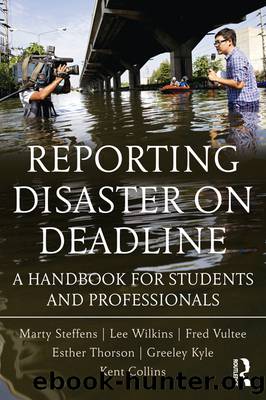Reporting Disaster on Deadline by Wilkins Lee;Steffens Martha;Thorson Esther;Kyle Greeley;Collins Kent;Vultee Fred;

Author:Wilkins, Lee;Steffens, Martha;Thorson, Esther;Kyle, Greeley;Collins, Kent;Vultee, Fred;
Language: eng
Format: epub
Publisher: Taylor & Francis Group
It should be noted that implicit in this categorization is the assumption that specific frames in disaster coverage tend toward positive or negative connotations. Given that natural disasters, by definition, are inherently negative events, it is not surprising that most of the frames associated with them carry negative connotations. Although exceptions in individual stories may exist, the frames of blame, conflict, devastation, economics, helplessness and prediction seem inherently negative in terms of the facts they present and some of the emotions they arouse. Solidarity, on the other hand, is more positive.
Much of the risk communication scholarship has been critical of news organizationsâ portrayal of disasters (Kreps, 1980; Singer & Endreny, 1993). The major criticisms include: (1) the media sensationalize disasters; (2) coverage often includes inaccurate information; (3) news reports focus primarily on warnings of impending disasters and on the disaster event itself, but provide little contextual analysis of risk and hazard mitigation (e.g., examining the public costs of earthquake-resistant infrastructure systems) and (4) the media perpetuate âmythsâ of disaster behavior (e.g., Drabek, 1986; Parker, 1980). Such myths include, for example, assumptions of mass panic, helpless victims and a breakdown of social order (Dynes, 1970). Many of these criticisms, based as they are on systematic academic study, are examined in more detail in Chapter 2. As such, some scholars recommend the media place more emphasis on âpost-disaster activity to determine causes and fix blame and responsibilityâ (Lang & Lang, 1980: 279).
Despite these criticisms, studies in the risk communication literature show that the media play an important role in issuing warnings to the public at times of imminent disaster (e.g., Drabek, 1986; Driscoll & Salwen, 1993; Kreps, 1980; Krimsky & Plough, 1988; Ledingham & Masel-Walters, 1985, 1989; Scanlon, 1976; Sood, Stockdale, & Rogers, 1987; Spencer, Seydlitz, Lacks, & Triche, 1992; Turner, 1980; Wenger, James, & Faupel, 1980; Wilkins, 1985; Wilkins & Patterson, 1987). Scholars have also noted the role of the news media in providing mobilizing information (e.g., Garner, 1994; Lemert, 1989; Spencer et al., 1992).
Wilkins and Patterson (1987: 91) have suggested the need for a ânews heuristic for riskâ; that is, a political frame that looks at risk as a tradeoff between social benefits and harms, emphasizing analysis of the elements of risk, anticipating risk, and providing mobilizing information and context. Application of framing analysis to media content and audience perceptions may be helpful for identifying such heuristics in risk and disaster communication.
A summary of these findingsâincluding those that are critical of media content while also asserting that news content is important for the public and the communityâsuggests that journalists think a little bit differently about the narrative arc of disaster coverage. A different approach to the overall storyâa public health-based approachâcan promote different individual stories that still meet the criteria of newsworthiness while also fostering shift toward the central role of mitigation in disaster coverage.
Public Health-Based Disaster Reporting
As pointed out elsewhere in this handbook, a common assumption about news, particularly disaster news, is that it plays a crucial public service role.
Download
This site does not store any files on its server. We only index and link to content provided by other sites. Please contact the content providers to delete copyright contents if any and email us, we'll remove relevant links or contents immediately.
Whiskies (Collins Gem) by dominic roskrow(44273)
Spell It Out by David Crystal(35846)
Cecilia; Or, Memoirs of an Heiress — Volume 1 by Fanny Burney(32060)
Cecilia; Or, Memoirs of an Heiress — Volume 3 by Fanny Burney(31455)
Cecilia; Or, Memoirs of an Heiress — Volume 2 by Fanny Burney(31406)
Beautiful Disaster by McGuire Jamie(24998)
Trainspotting by Irvine Welsh(21021)
Chic & Unique Celebration Cakes by Zoe Clark(19793)
How High Can a Kangaroo Hop? by Jackie French(18671)
Twilight of the Idols With the Antichrist and Ecce Homo by Friedrich Nietzsche(18297)
The Secret History by Donna Tartt(18157)
Cat's cradle by Kurt Vonnegut(14757)
All the Missing Girls by Megan Miranda(14723)
Ready Player One by Cline Ernest(13979)
Fifty Shades Freed by E L James(12910)
Crooked Kingdom: Book 2 (Six of Crows) by Bardugo Leigh(11964)
4 3 2 1: A Novel by Paul Auster(11788)
For the Love of Europe by Rick Steves(11454)
Grundlagen Kreatives Schreiben (German Edition) by Helfferich Pia(10286)
